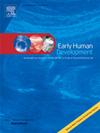早产儿动脉导管未闭闭合药物治疗失败的临床和超声心动图预测因素:基于风险的治疗方法的见解
IF 2
3区 医学
Q2 OBSTETRICS & GYNECOLOGY
引用次数: 0
摘要
目的本研究旨在确定早产儿早期临床和超声心动图标记物,这些标记物可能预测药物治疗关闭高危动脉导管未闭(PDA)失败。研究设计:这是一项在III级新生儿重症监护室进行的观察性队列研究。根据EL-Khuffash PDA严重程度评分(PDAsc),如果出生29周的婴儿被认为是高风险的,则接受药物治疗。治疗失败的婴儿与治疗成功的婴儿进行比较。结果110例患儿为高危人群(58例有反应,52例无反应)。治疗失败组和治疗成功组婴儿的临床和超声心动图特征的初步差异分别包括胎龄较低(25.2±1.3 vs 25.9±1.4);p & lt;0.01),较高的PDAsc(7.8±1.9 vs 7.0±1.5;p & lt;0.01),先兆子痫发生率较低(3例(6%)vs 12例(21%);p = 0.02),降低二尖瓣E:比率(0.78±0.13 vs 0.90±0.27;p = 0.02),高拉:奥比(1.7±0.6 vs 1.4±0.5;P = 0.02),腹腔下动脉收缩速度(m/s)(0.36±0.12 vs 0.46±0.20;p = 0.02)和更高的整体纵向应变(GLS)(%)(20.8±3.1 vs 18.1±4.4;p & lt;0.01)。在多变量logistic回归模型中,GLS仍然是药物治疗失败的唯一独立预测因子(OR 0.83, 95% CI 0.70-0.98, p = 0.03)。结论:这些发现突出了高危早产儿的独特亚组,他们不太可能对药物治疗有反应,强调了个体化PDA管理方法的必要性。将临床和超声心动图标记与基于风险的评分系统相结合,可以改善治疗无反应的早期识别,并指导替代治疗策略。本文章由计算机程序翻译,如有差异,请以英文原文为准。
Clinical and echocardiographic predictors of medical therapy failure for patent ductus arteriosus closure in preterm infants: Insights from a risk-based treatment approach
Objective
This study aims to identify initial clinical and echocardiographic markers in preterm infants which may predict failure of medical therapy to close a high-risk patent ductus arteriosus (PDA).
Study design
This was an observational cohort study conducted in a level III NICU. Infants born <29 weeks gestation were treated with medical therapy if they were deemed high-risk as per the EL-Khuffash PDA Severity Score (PDAsc). Treatment-failure infants were compared to treatment-success infants.
Results
110 infants were high-risk (58 responders, 52 non-responders). Initial differences in clinical and echocardiographic characteristics between infants in the treatment-failure and treatment-success groups, respectively, included a lower gestational age (25.2 ± 1.3 vs 25.9 ± 1.4; p < 0.01), higher PDAsc (7.8 ± 1.9 vs 7.0 ± 1.5; p < 0.01), lower incidence of pre-eclampsia (3 (6 %) vs 12 (21 %); p = 0.02), lower mitral E:A ratio (0.78 ± 0.13 vs 0.90 ± 0.27; p = 0.02), higher LA:Ao ratio (1.7 ± 0.6 vs 1.4 ± 0.5; p = 0.02), lower celiac artery systolic velocity(m/s) (0.36 ± 0.12 vs 0.46 ± 0.20; p = 0.02) and higher global longitudinal strain (GLS) (%) (20.8 ± 3.1 vs 18.1 ± 4.4; p < 0.01). In a multivariate logistic regression model, GLS remained the only independent predictor of medical therapy failure (OR 0.83, 95 % CI 0.70–0.98, p = 0.03).
Conclusion
These findings highlight a distinct subgroup of high-risk preterm infants who are unlikely to respond to medical therapy, emphasising the need for an individualised approach to PDA management. Integrating clinical and echocardiographic markers with risk-based scoring systems may improve early identification of treatment non-responders and guide alternative therapeutic strategies.
求助全文
通过发布文献求助,成功后即可免费获取论文全文。
去求助
来源期刊

Early human development
医学-妇产科学
CiteScore
4.40
自引率
4.00%
发文量
100
审稿时长
46 days
期刊介绍:
Established as an authoritative, highly cited voice on early human development, Early Human Development provides a unique opportunity for researchers and clinicians to bridge the communication gap between disciplines. Creating a forum for the productive exchange of ideas concerning early human growth and development, the journal publishes original research and clinical papers with particular emphasis on the continuum between fetal life and the perinatal period; aspects of postnatal growth influenced by early events; and the safeguarding of the quality of human survival.
The first comprehensive and interdisciplinary journal in this area of growing importance, Early Human Development offers pertinent contributions to the following subject areas:
Fetology; perinatology; pediatrics; growth and development; obstetrics; reproduction and fertility; epidemiology; behavioural sciences; nutrition and metabolism; teratology; neurology; brain biology; developmental psychology and screening.
 求助内容:
求助内容: 应助结果提醒方式:
应助结果提醒方式:


